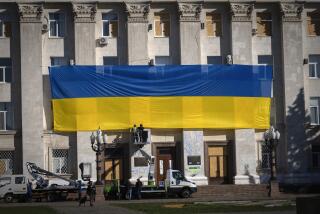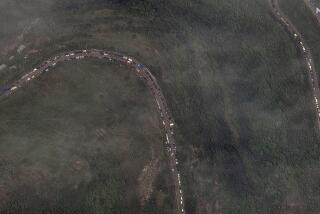Toll Hits 22 as Armenians, Soviets Clash : Nationalism: Troops battle militants outside a military base. The scale of violence in Yerevan is called unprecedented.
- Share via
MOSCOW — The death toll grew to at least 22 in gun battles in the Armenian capital of Yerevan as militants armed with machine guns and Molotov cocktails fought Soviet troops, casting a deadly pall on Monday’s ceremonies marking the Transcaucasian land’s brief independence.
“Instead of independence day celebrations, we have a day of mourning,” the republic’s Communist Party leader, Vladimir Movsisyan, said as he went on television to appeal to his people for calm and to lament a “tragic day for Armenia.”
Word of the first shoot-out, at the train station in Yerevan, surfaced Sunday when state-run Soviet media reported that six armed militants had been killed in an attack on Soviet internal security troops. But details of a far deadlier gunfight outside a military base, in which at least 15 people, including a soldier, died, became known only later.
Another Armenian was reported killed in Yerevan by gunfire from Soviet troops early Monday. Though Armenia has been locked since 1988 in an often brutal territorial dispute with the neighboring Soviet republic of Azerbaijan, never had death and violence on such a scale intruded into the city of 1.2 million, and many of its inhabitants were admittedly bewildered and bracing for more unrest.
For Mikhail S. Gorbachev, the Soviet president, who already faces widespread discontent over his economic reforms and a pro-independence movement in the Baltic republics, it was another possible crisis to preoccupy him as he leaves today for Canada and a summit meeting in Washington with President Bush.
“This clash with the military is unprecedented; nothing like this has ever happened before in Yerevan,” Levon G. Airamyants, deputy chief of the political information department at Armenia’s Foreign Ministry, said by telephone. “The people are stunned.”
Leaders of nationalist Armenian groups such as the Karabakh Committee called the gun battles a provocation to discredit the grass-roots Armenian National Movement, which scored an impressive victory in recent parliamentary elections against Communist Party candidates and was planning this week to nominate its slate for municipal offices.
But Col. Gen. Yuri Shatalin, in Yerevan to direct Interior Ministry troop units charged with keeping the peace, placed the blame for the violence squarely on Armenian authorities, saying they have long been in cahoots with the armed extremists whose actions they are now deploring.
“Bloodshed in Yerevan is the result of overt connivance of the republican leadership and law enforcement agencies with illegal armed groups,” Shatalin told the official news agency Tass. “They did not devote proper attention to the fact that a major part of the militant armed formations are concentrated in the capital of the republic, that they drive around the city in stolen cars, carrying captured weapons.”
He demanded “resolute measures” to seize their arms, but such a step would be politically dangerous for the Armenian leadership. The armed groups have flourished in the two-year feud with Azerbaijan about jurisdiction over the disputed Nagorno-Karabakh district, and they are regarded by many Armenians as a sort of national guard protecting them from Azerbaijani attack.
On Monday afternoon, as many as 100,000 people rallied in Yerevan in a somber mood to commemorate the two years of Armenian independence in 1918-20, before Russian Bolsheviks, aided by their Armenian sympathizers, took power and proclaimed the rocky homeland north of Turkey a Soviet republic.
Fearing that troops angered by the Sunday violence might attack them, organizers of the ceremony scratched a planned march to the grave of the first chairman of the Armenian Parliament.
Though accounts of what happened Sunday at the military base were still incomplete, versions offered by Armenians conflicted with Soviet accounts. Rafael A. Popoyan, a Yerevan activist who has furnished reliable information in the past, accused the soldiers of firing first, and apparently at random.
“By 4 or 5 p.m., a large armored column, 16 armored personnel carriers in all, started to move from the interior troops’ garrison on the outskirts of Yerevan toward the center,” Popoyan said by telephone. “Residents tried to stop the column by putting heavy trucks in its way and hastily building barricades.”
Those actions didn’t work, Popoyan said, and the convoy entered central Yerevan via Erebuni Boulevard, “where it suddenly started shooting at people who were passing by and at windows, killing many people,” he claimed. His account could not be independently verified.
The Armenian National Movement reported that the dead included a 13-year-old girl and that 30 civilians were injured in the cross-fire.
The Tass account was completely different. It said about 50 armed militants blockaded the barracks of an Interior Ministry regiment by seizing a hill that commanded the area and climbing into the attics of nearby buildings.
They blasted the base with firearms, including machine guns, killing the unit’s deputy commander, a Lt. Col. Chekmarev, Tass said. In the return fire, 14 militants were reported killed and 36 wounded.
Karen Shakhnazaryan of the official Armenpress news agency in Yerevan said the Armenians were armed with Molotov cocktails and submachine guns, presumably stolen from military or police arsenals. State-run Soviet television news showed footage of armed Armenians bobbing and weaving as they ran for cover.
After the convoy left the base, armed columns of militants converged on the center of Yerevan, where reinforcements of internal security troops were also being sent, Popoyan said. More moderate Armenians negotiated the withdrawal of the armed irregulars, and, according to David Motevosayn of the Armenian National Movement, the deputy chief of Yerevan’s military garrison pledged that troops would not be used further under any circumstances.
But Armenian activists accused the deputy chief of breaking his word only hours later. At 6 a.m. Monday, Popoyan said, “armored personnel carriers drove around the city at breakneck speed.”
Meanwhile, soldiers reportedly shot up the headquarters of the Armenian National Movement. No one inside was hurt, but a 24-year-old man was killed as he slept in his parked car in front of the building, Popoyan said. “For some reason, the soldiers towed the car with its dead occupant to the (Armenian Communist Party) Central Committee building and left it there,” he added.
Though Tass repeated official contentions that the Interior Ministry troops at Yerevan’s train station had fired only when attacked, Leon Grogoryan of the Armenian Foreign Ministry’s press department claimed that the soldiers shot first.
“An armed group entered the building and demanded the MVD (Interior Ministry) people hand over their arms. But the MVD people disregarded their order and opened fire,” Grogoryan said.
Popoyan also noted that if the militants had fired first, they must have been terribly poor marksmen since, according to Tass, none of the soldiers were killed while six Armenians were.
However, official Soviet reports said that 10 of the soldiers were wounded, and Armenpress reported Monday that one had died, though that report could not be confirmed.
Popoyan said that according to the most recent information possessed by the Armenian National Movement, 23 Armenians were killed in Yerevan on Sunday, nine innocent civilians caught in the cross-fire and 14 militants carrying arms.
BACKGROUND
President Mikhail S. Gorbachev’s reforms have unleashed fierce ethnic tensions in the Transcaucasus region, suppressed for decades by the Kremlin. Passions are running high in Armenia over Nagorno-Karabakh--a predominately Armenian enclave that is inside neighboring Azerbaijan and is administered from the Azerbaijani capital, Baku. In the last two years, hundreds have been killed in clashes between Armenians and Azerbaijanis over the territory. Last year, Gorbachev brought the enclave under Moscow’s direct rule. But his later decision to hand it back to Baku has turned Armenian nationalist anger on the Kremlin.
More to Read
Sign up for Essential California
The most important California stories and recommendations in your inbox every morning.
You may occasionally receive promotional content from the Los Angeles Times.













